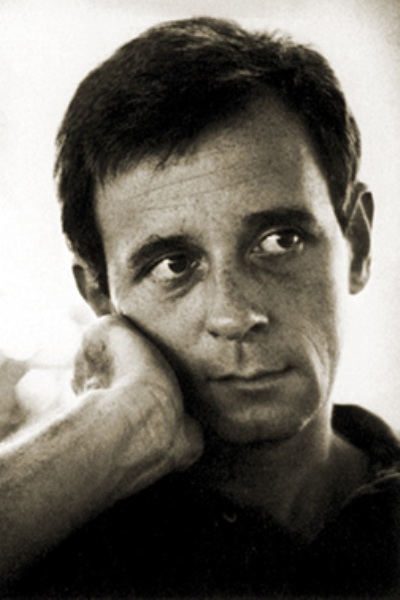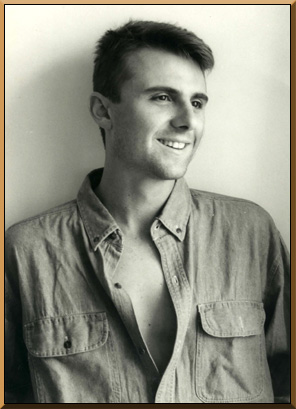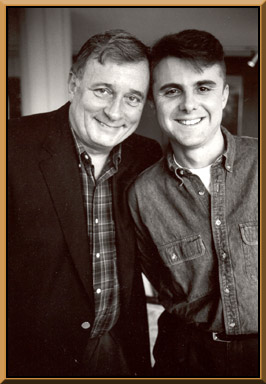Edmund White (born January 13, 1940)

Edmund Valentine White III (born January 13, 1940) is an American author and literary critic. He is a member of the faculty of Princeton University's Program in Creative Writing. Since 1995 he has lived with his partner Michael Carroll (born 1965), a writer; despite this relationship White has strongly mixed feelings on the subject of gay marriage. In part, he agrees with those who dismiss it as buying into “straight” culture, but the old Stonewall rebel in him relishes a fight.
Born in Cincinnati, Ohio, he largely grew up in Chicago. White attended Cranbrook School in Bloomfield Hills, Michigan as a boy, then studied Chinese at the University of Michigan. He later worked in New York as a journalist. From 1983 to 1990 he lived in France.

White's best-known work is
A Boy's Own Story, the first volume of an autobiographical-fiction series that continued with The Beautiful Room Is Empty and The Farewell Symphony, describing stages in the life of a gay man from boyhood to middle age. Several characters in these latter two novels are recognizably based on well-known individuals from White's New York-centered literary and artistic milieu. White was a member of The Violet Quill, a gay writer's group that met briefly from 1980-1981. The Violet Quill included other prolific gay writers like Andrew Holleran and Felice Picano.
An earlier novel Nocturnes for the King of Naples (1978) and a later novel The Married Man (2000) are also gay-themed and draw heavily on White's own life. In 2006 he published a nonfiction autobiography entitled My Lives. It is unusual in that it is organized by theme, rather than chronologically. White's autobiographical works are frank and unapologetic about his promiscuity and his HIV-positive status. In 1982, White helped found the Gay Men's Health Crisis, in New York City. In Paris, in 1984, he was closely involved in the foundation of the French HIV/AIDS NGO AIDES.

Edmund Valentine White III (born January 13, 1940) is an American author and literary critic. He is a member of the faculty of Princeton University's Program in Creative Writing. Since 1995 he has lived with his partner Michael Carroll (born 1965), a writer; despite this relationship White has strongly mixed feelings on the subject of gay marriage. In The Married Man, Austin Smith is pushing fifty, loveless and drifting, until one day he meets Julien, a much younger, married Frenchman.

White has explained: "Writing has always been my recourse when I've tried to make sense of my experience or when it's been very painful. When I was 15 years old, I wrote my first (unpublished) novel about being gay, at a time when there were no other gay novels. So I was really inventing a genre, and it was a way of administering a therapy to myself, I suppose."
He is openly gay and some of his works focus on gay themes. His debut Forgetting Elena (1973) is set on an imaginary island. The novel can be read as commenting on gay culture, but only in a highly coded and indirect manner. Caracole (1985) centers on heterosexual characters, relationships, and desires. Fanny: A Fiction (2003) is a historical novel about Frances Trollope and Frances Wright. White's 2006 play Terre Haute (produced in New York City in 2009) portrays discussions that take place when a prisoner based on Timothy McVeigh is visited by a writer based on Gore Vidal. (In real life McVeigh and Vidal corresponded but did not meet.)
White has been influential as a literary and cultural critic, particularly on gay issues. He has received many awards and distinctions; among these, he is a member of the American Academy of Arts and Letters and an Officier de l'Ordre des Arts et des Lettres.
Source: http://en.wikipedia.org/wiki/Edmund_White"San Francisco is where gay fantasies come true... The problem the city presents is whether, after all, we wanted there particular dreams to be fulfilled - or would we have preferred others? Did we know what price these dreams would exact?" --Edmund White, 1980
A Boy's Own Story is Edmund White's best book, hands down. Like Maxwell, White's writing, sentence for sentence is just gorgeous, surprising and generous to his people and to his world. --Michael Klein
What a happy accident my discovery of Noturnes for the King of Naples by Edmund White was. I was 17-years-old and in NYC to visit Paul (the guy I eventually won my First Amendment right to go to the prom with.) I was in a rush to appear terribly adult, so I pulled a book off the bookstore shelf quickly, as though I knew exactly what I was looking for. Well, the gay gods must have been watching over me that day because this book was my constant companion during senior year in high school. I read this book at the exact right time in my life when I was susceptible to the influence of Mr. White's immaculate way with language, and for that reason it feels as though this book changed my life. In the years since this book's publication, Edmund White has written many other straightforward, less baroque gay stories; but for my money, this is Mr. White letting his freak flag fly. P.S. As much as I respect Gore Vidal's opinions, I have not recognized the "vicious" content of Mr. White's work that Mr. Vidal has publicly complained about recently. --Aaron Fricke
Though I would come to dislike White´s subsequent work, I find A Boy's Own Story to be just about perfect. As a sexual awakening, it´s competitive with The Catcher in the Rye, and I´ll never forget flipping through it in my college bookstore and reading the line, "Go head, fill `er up," and realizing I had to own it. I need to re-read this soon-it never gets old, unlike all boys with their own stories. --Matthew Rettenmund
Edmund White has always mixed the highbrow with the lowlife, the backroom with the salon, in books that are intelligent, frank, outspoken, and not politically correct. He strikes me as someone who has been a lightning rod for readers, who seem to love to pick his opinions apart, even though sentence for sentence, I think he writes better than almost anyone else today. The Beautiful Room is Empty - the follow-up to A Boy’s Own Story - is the one of his I treasure the most. His autobiographical narrator wallows in self-loathing (including some painfully funny therapy sessions with a completely useless analyst) even as he’s having loads of covert sex (in men’s rooms everywhere), all the while inching toward self-definition. It’s a fearless portrait of the middle-class repressiveness that the ’60s obliterated. The novel ends at Stonewall. By the time you get there, you’re ready for a revolution. Related reading: In his memoir My Lives, he covers some of the same ground, but as nonfiction. It makes for a fascinating comparison. --K.M. Soehnlein
Aside from the legend in Gay literature that Edmund White has become, A Boy’s Own Story was perhaps the first truly ‘literate’ work of Gay fiction that I saw myself in. I know that this sort of ‘serious’ literature is not everyone’s cup of tea, but “A Boy’s Own Story” is on some level, to me anyway, every Gay boy’s story, at least in spirit. I don’t know how not to be inspired by White’s prose. Touching. True. And oh so keenly written. --Dan Stone
I suppose this list wouldn’t be complete without an Edmond White mention. I always found his work to be slightly confusing, yet strangely compelling. His work is composed of flowing prose that I can never hope to achieve, nor, I suppose, do I want to. White’s books are intellectually inspiring, delving more into the emotions than the carnal lust. However, A Boy’s Own Story was one of my very first gay romance novels. So it needs to be on this list. --G.A. Hauser
Often labelled the ‘gay Catcher in the Rye’ A Boy’s Own Story is the story of a teen trying to discover himself in a much more unwelcoming period of the 50s. A bit bleak and heavy going at times, this was followed up by two sequels, yet I never found them as appealing as this one. --Sean Kennedy
The novelist, essayist, and biographer Edmund White is skeptical about the notion of a gay sensibility. "What we can discuss... is the gay taste of a given period," he wrote in States of Desire. "A taste cultivated (even by some heterosexuals) or rejected (even by many homosexuals). What we can detect is a resemblance among many gay works of art made at a particular moment - a resemblance partially intended and partially drawn without design from a shared experience of anger or alienation or secret, molten camaraderie." Elsewhere, White argued that "any discussion of a group's sensibility (the "black sensibility"? the "Jewish sensibility"?) is too general to be useful."
The AIDS epidemic would cause more pain and loss than anyone within the gay community had hitherto imagined possible. And the deaths among artists would ravage the creativity of American culture for at least a generation. A typical disaster was the devastation of the Violet Quill, a group of seven novelists formed at the end of the 1970s. Its members were Edmund White, then working on A Boy's Own Story; Felice Picano; Andrew Holleran; Robert Ferro; George Whitmore; Christopher Cox; and Michael Grumnley. Vito Russo, who was writing The Celluloid Closet, was also an occasional visitor. By the end of 1991, only White, Holleran, and Picano were still alive.
"For me these losses were definitive," Edmund White wrote. "The witnesses to my life, the people who had shared references and sense of humor, were gone. The loss of all the books they might have written remains incalculable." --The Gay Metropolis: The Landmark History of Gay Life in America by Charles Kaiser

Edmund White, 1985, by Robert Giard (http://beinecke.library.yale.edu/dl_crosscollex/brbldl_getrec.asp?fld=img&id=1124085)American photographer Robert Giard is renowned for his portraits of American poets and writers; his particular focus was on gay and lesbian writers. Some of his photographs of the American gay and lesbian literary community appear in his groundbreaking book Particular Voices: Portraits of Gay and Lesbian Writers, published by MIT Press in 1997. Giard’s stated mission was to define the literary history and cultural identity of gays and lesbians for the mainstream of American society, which perceived them as disparate, marginal individuals possessing neither. In all, he photographed more than 600 writers. (http://beinecke.library.yale.edu/digitallibrary/giard.html)
Further Readings:

The Married Man by Edmund White
Paperback: 336 pages
Publisher: Vintage (September 11, 2001)
Language: English
ISBN-10: 0679781447
ISBN-13: 978-0679781448
Amazon: The Married Man
In Edmund White's most moving novel yet, an American living in Paris finds his life transformed by an unexpected love affair.
Austin Smith is pushing fifty, loveless and drifting, until one day he meets Julien, a much younger, married Frenchman. In the beginning, the lovers' only impediments are the comic clashes of culture, age, and temperament. Before long, however, the past begins to catch up with them. In a desperate quest to save health and happiness, they move from Venice to Key West, from Montreal in the snow to Providence in the rain. But it is amid the bleak, baking sands of the Sahara that their love is pushed to its ultimate crisis.
More Particular Voices at my website: http://www.elisarolle.com/, My Ramblings/Particular Voices
More Spotlights at my website: http://www.elisarolle.com/, My Lists/Gay Novels
This journal is friends only. This entry was originally posted at http://reviews-and-ramblings.dreamwidth.org/1411697.html. If you are not friends on this journal, Please comment there using OpenID.